How the Land Becomes Sacred Class 7 Notes Social Science Chapter 8 Free PDF
Introduction
Sacredness is about places, journeys, or natural elements that are holy and deeply respected in religious or spiritual beliefs. In India, the land becomes sacred through pilgrimages, sacred sites, and the belief that nature, like rivers and mountains, is divine.
- Sacred sites and pilgrimage networks connect people across India, shaping their culture and traditions.
- Sacred geography helped unite India’s diverse regions by encouraging cultural exchange and shared values.
The Bhagavata Purana teaches that all of nature—air, water, fire, earth, plants, rivers, seas, and creatures—is part of the divine body. The figure 8.1 reflects this idea, showing how the land itself becomes sacred and connects people through faith, culture, and tradition.
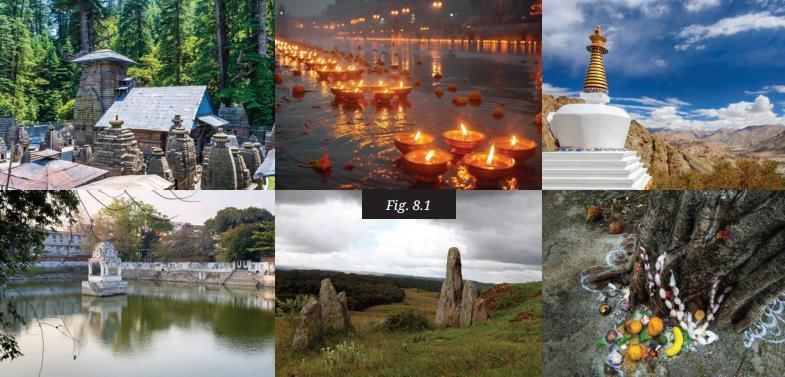
What is ‘Sacredness’?
Sacredness refers to something holy or highly significant in a religious or spiritual context, deserving of respect. It can be a special location, like a shrine, or a journey, such as a pilgrimage, that feels divine. Thus, sacredness is connected not only to religion and spirituality but also to geography, various traditions, and, in the case of India, to something more that we will explore further.
 Sacred Places in India
Sacred Places in India
In Sikhism, Takhts are seats of spiritual authority, such as:
- Takht Sri Patna Sahib (Patna)
- Akal Takht (part of the Golden Temple, Amritsar)
- Takht Sri Keshgarh Sahib (Anandpur)
Sikhs aspire to visit these as pilgrimages since they are linked to important Gurus. Sikh tradition also records pilgrimages by Gurus, including Guru Nanak, to places like Haridwar, Prayag, Mathura, Varanasi, Ayodhya, Puri, and some Muslim shrines.
India has long been a land of pilgrimages, with sacred sites ranging from Badrinath, Kedarnath, and Amarnath in the Himalayas to Kanyakumari in the south. These journeys reflect a sense of one country and one culture uniting people across regions.
Pilgrimages
Pilgrimages, or tirthayatras, are journeys to sacred sites called tīrthas, important in Indian culture for over 3,000 years.
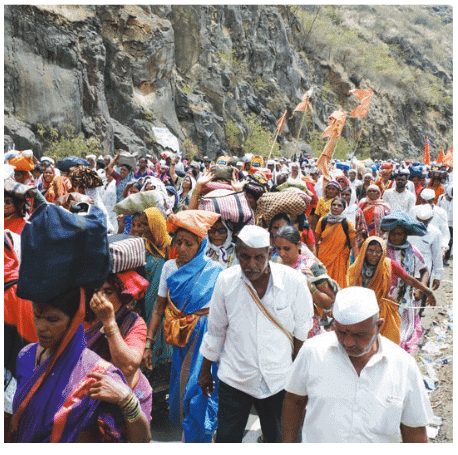 Pilgrimages
Pilgrimages
- This ancient tradition of pilgrimage is not only a physical journey but also an inner one that follows a specific code of conduct.
- An example from historian Dharampal: They mentioned a three-month pilgrimage to Rameswaram and other sites, coming from two villages north of Lucknow.
- In the Jain tradition, tīrthas are associated with places where the Tīrthankaras attained liberation or where significant events of their lives occurred.
- Trees, ponds, hills and mountains that the Tīrthankaras visited or meditated at are also considered sacred.
- Examples of such places include Mount Abu, Girnar and the Shatrunjaya hill in Saurashtra (Gujarat).
- Another example is the pilgrimage to Sabarimala temple (Kerala), dedicated to the deity Ayyappa, which draws over ten million devotees every year.
- This hilltop shrine was traditionally reached by an immensely difficult trek through hills and forests.
- Such a challenging approach, common to many hilltop or mountain shrines all over the country, symbolises the difficulties of the inner path, with natural landmarks along the route being considered sacred.
Connecting Cultures
What draws people from the south to the north and from the north to the south in these grand pilgrimages?
It is the feeling of one country and one culture. Since Vedic times, rivers have been revered in India.
More Sacred Sites
- In Hinduism, folk, and tribal beliefs, nature like mountains, rivers, trees, and animals is sacred.
- Rivers are regarded as devis (goddesses), and some trees, plants, and animals are considered holy, reflecting a belief in a divine presence in nature.
- The entire Earth is considered Mother Earth or Bhudevi.
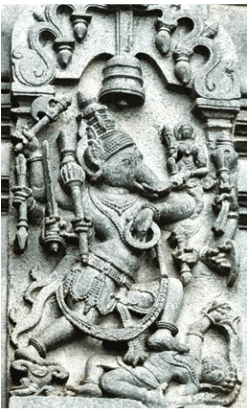 Vishnu in boar formExamples of sacred sites:
Vishnu in boar formExamples of sacred sites:
- Niyam Dongar hill in Jharkhand, sacred to the Dongria Khond tribe as the home of Niyam Raja, where cutting trees is forbidden.
- In Sikkim, sacred mountains, caves, lakes, and hot springs are protected from damage.
- In the Nilgiris, the Toda tribe considers mountain peaks, plants, Shola forests, wetlands, and stones sacred.
Becoming Aware of Sacred Geography
Sacred geography pertains to important sites in India that are linked together, forming networks. For instance, some Hindus aim to undertake the Char Dhām Yātrā, where four sacred locations are intentionally placed in the southern, northern, eastern, and western parts of India, promoting travel throughout the country.
 Char Dhams
Char Dhams
- The 12 Jyotirlingas, sacred to Shiva, and 51 Shakti Pithas, linked to Shakti, cover India’s map, including Bangladesh and Pakistan.
- A story about the Shakti Pithas: When Sati died, Viṣhṇu cut her body, and parts fell across India, making those places sacred as the divine mother’s body.
- These networks make the entire land sacred, uniting India’s diverse regions.
- Pilgrims traveling to these sites encounter different languages, customs, and foods, but also see shared Indian values.
Sacred Ecology
Tīrthas are often near rivers, lakes, forests, or mountains, seen as sacred spaces called punyakshetra. Viewing nature as sacred helps protect it, as humans feel connected to it. Sacred ecology blends geography, culture, and spirituality to preserve nature.
Rivers and Sangams (Confluence of Rivers)
- Rivers have been worshipped since Vedic times, as seen in the Nadistuti Sūkta of the Rigveda, praising 19 ancient rivers.
- Rituals invoke rivers like Ganga, Yamuna, Godavari, Sarasvati, Narmada, Sindhu, and Kaveri.
- These rivers are lifelines, and their sources, tributaries, and paths are sacred, visited by pilgrims.
- People respectfully call rivers “Ganga ji” or “Yamuna ji” in local languages.
- Sangams, where rivers meet, like in Prayagraj (Ganga, Yamuna, and invisible Sarasvati), are especially holy.
Kumbh Mela
- The Kumbh Mela is a major pilgrimage held every six years in Haridwar, Prayagraj, Nashik, and Ujjain.
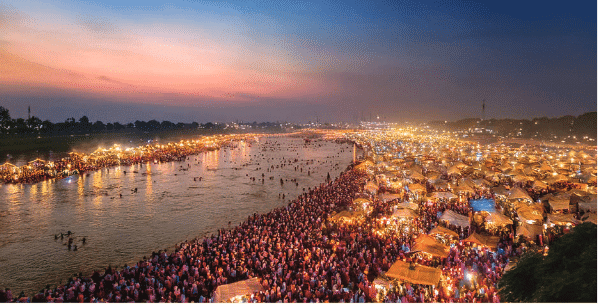 Kumbh Mela
Kumbh Mela
- It comes from the legend of amrita manthana, where gods and demons churned the ocean for amrita (nectar).
- Viṣhṇu, as Mohini, took the amrita pitcher, and drops fell at the four Kumbh Mela sites, making them holy.
- A dip in the rivers during the Kumbh Mela is considered very auspicious.
- In 2025, about 660 million people joined the Kumbh Mela, showing its importance.
- UNESCO listed the Kumbh Mela as an “intangible heritage of the world” for its cultural value.Question for Chapter Notes: How the Land Becomes SacredTry yourself:What is the significance of the Kumbh Mela?View Solution
Mountains and Forests
Mountains are linked to legends and deities, seen as gateways to heaven due to their height. Many tīrthas and temples, like those in the Himalayas, are on hilltops, symbolizing a spiritual journey.
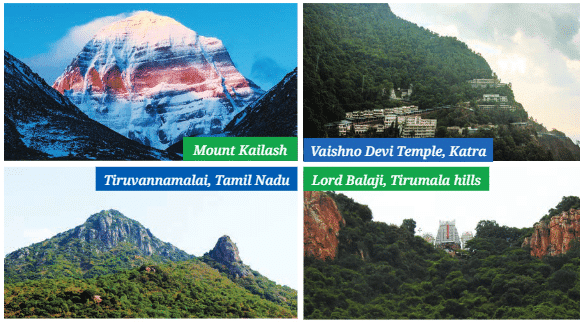 Sacred Mountains
Sacred Mountains
- Pilgrims once walked tough mountain trails, testing their physical and mental strength, though roads now make access easier.
- Forests are sacred in many traditions, often seen as homes of deities.
Trees, Forests and Sacred Groves
Trees like the peepul (bodhi tree) are sacred in Hinduism, Buddhism, Sikhism, and Jainism, often adorned with turmeric and kumkum. The peepul at Mahabodhi Temple in Bodh Gaya is believed to be linked to the tree under which Buddha attained enlightenment
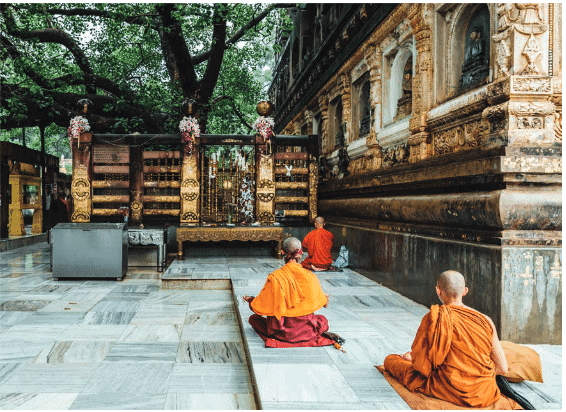 Mahabodhi Temple at Bodh Gaya
Mahabodhi Temple at Bodh Gaya
- Peepul trees have medical uses (leaves for skin, bark for stomach issues) and support birds and animals year-round.
- A Mohenjo-daro seal shows peepul leaves, proving its importance for millennia.
- Sacred groves are protected forests seen as deity homes, like Ryngkew in Meghalaya, preserving biodiversity and water bodies.
- Examples of sacred grove names: kāvu (Malayalam), kovilkadu (Tamil), devare kādu (Kannada), devarāi (Marathi), sarnā (Jharkhand).
- In Thanjavur, Tamil Nadu, sacred groves’ deities protect fruit bats, which help pollinate flowers and spread seeds, creating harmony between nature and humans.
- Many sacred groves are shrinking due to farming and industry, but some communities still protect them.
From Pilgrimage to Trade
- Pilgrims and traders often meet on pilgrimage routes, benefiting both.
- Pilgrims buy goods from traders, and some traders visit sacred sites while selling wares.
- Pilgrimage routes and trade routes often overlap, like Uttarapatha (northwest to east) and Dakshinapatha (Kaushambi to Pratiṣhṭhāna).
- Traded goods included shells, pearls, gold, diamonds, cotton, spices, and sandalwood.
- These interactions led to sharing of goods, ideas, and stories, enriching India’s culture.
Sacred Geography beyond India
The concept and practice of sacred geography are not unique to India.
- Ancient Greece had sacred mountains and groves.
- Native Americans viewed nature as sacred.
- The Maoris, the indigenous people of New Zealand, regard the Taranaki Maunga mountain as their ancestor and therefore as sacred; after many representations by the Maoris, a law recently granted this mountain the rights and responsibilities of a human being.
- The elders of the community represent the voice of the mountain or river threatened with destruction.
- The Yamuna in the north, the Mahanadi in the east, or the Kaveri in the south are all sacred rivers.
- The Niyam Dongar hill in the Niyamgiri Range of Jharkhand is sacred to the Dongria Khond tribe.
Restoring and Conserving the Sacred
- The bond between people and sacred geography sustained Indian civilization for thousands of years, creating shared values.
 Pollution at Sacred Sites
Pollution at Sacred Sites
- Today, this bond is strained as sacred places like rivers (Yamuna, Mahanadi, Kaveri) are polluted.
- When rivers or mountains face harm from overuse or development, people speak up to protect their deities and environment.
- Sacred geography supports sustainability, offering lessons for global environmental care.
- It is everyone’s duty to protect sacred places, as reminded by India’s Constitution.Question for Chapter Notes: How the Land Becomes SacredTry yourself:What is the peepul tree known for in various religions?View Solution
Points to Remember
- All religions in India have sacred places across the land.
- In Buddhism, Jainism, and Sikhism, sacred sites are linked to great figures or events.
- Hinduism has many pilgrimage sites, supporting personal growth, trade, and cultural unity across India.
- In Hindu, tribal, and folk traditions, the land itself is sacred.
- Sacred places are polluted due to neglect, and it is our duty to protect them as part of our national heritage.
Difficult Words
- Sacredness: The quality of being holy or deeply respected in religion or spirituality.
- Pilgrimage: A journey to a sacred place for religious or spiritual reasons.
- Shrine: A holy place linked to a divine figure, relic, or spiritual person.
- Relic: A body part or belonging of a holy person kept for reverence.
- Tīrthayātrā: A pilgrimage to a sacred site in Indian traditions.
- Tīrthankaras: In Jainism, a supreme teacher who guides people to a higher life.
- Punyakshetra: A sacred space, like a riverbank or mountain, in Indian beliefs.
- Char Dhām Yātrā: A pilgrimage to four sacred sites in India’s north, south, east, and west.
- Jyotirlingas: 12 sacred shrines dedicated to Shiva in Hinduism.
- Shakti Pithas: 51 sacred sites linked to the goddess Shakti.
- Nadistuti Sūkta: A Vedic hymn praising rivers.
- Sangam: The meeting point of rivers, considered holy.
- Kumbh Mela: A major pilgrimage at four sacred river sites, held every six years.
- Amrita: Divine nectar of immortality in Hindu stories.
- Sacred Groves: Protected forests seen as homes of deities, preserving nature.
- Biodiversity: The variety of plants and animals in a place.
- Sustainability: Using resources carefully to protect the environment for the future.
FAQs on How the Land Becomes Sacred Class 7 Notes Social Science Chapter 8 Free PDF
| 1. What does 'sacredness' mean and how is it perceived in different cultures? |  |
| 2. What are some examples of famous pilgrimage sites around the world? |  |
| 3. How do rivers and confluences, known as ‘sangams’, hold sacred significance in various cultures? |  |
| 4. What is the significance of Kumbh Mela and where is it held? |  |
| 5. How do mountains, forests, and sacred groves contribute to sacred geography? |  |

















